Discover the profound meanings behind 7 biblical valleys, each offering unique insights into life's challenges and spiritual journeys.
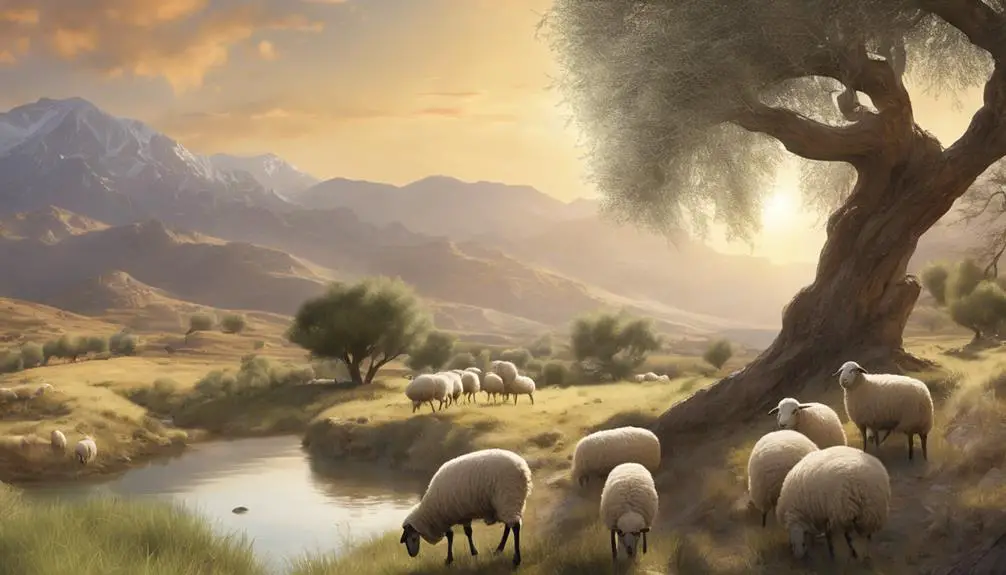
7 Valleys in the Bible
Navigating through the valleys mentioned in the Bible is like embarking on a journey through a landscape rich with spiritual symbolism and historical significance. You'll find each valley, from the Valley of the Shadow of Death to the Valley of Dry Bones, carries a unique narrative that has shaped the faith and understanding of generations.
These valleys, with their distinct contexts and lessons, offer more than just geographical references; they serve as metaphors for life's trials, faith's testing grounds, and sites of miraculous interventions. By exploring these valleys, you're not just tracing the paths of ancient figures; you're uncovering layers of meaning that could illuminate your own journey.
Let's consider what secrets and lessons each of these valleys holds, and why their stories remain relevant to us today.
Key Takeaways
- Biblical valleys symbolize a range of human experiences from despair to divine intervention.
- Valleys in scripture often serve as settings for lessons in faith, redemption, and spiritual growth.
- Each valley carries a unique narrative, from historical events to metaphorical journeys towards enlightenment.
- The study of valleys in the Bible reveals the interplay between divine providence and human struggle.
Valley of the Shadow of Death

In exploring the biblical landscapes, one encounters the 'Valley of the Shadow of Death,' a metaphorical terrain symbolizing deep despair and danger, woven into the fabric of Psalm 23. This Psalm, attributed to King David, serves as a profound reflection on the human condition, particularly focusing on the dynamics of fear and faith. Your understanding of this passage is crucial for a comprehensive grasp of biblical narratives and their application to fear management.
The 'Valley of the Shadow of Death' isn't just a poetic license but a deeply evocative symbol that resonates with the universal human experience of navigating through perilous phases of life. In the Psalm 23 Interpretation, this valley metaphorically represents the darkest trials and tribulations one faces. Yet, it also offers a profound message of hope and guidance. The assurance 'I will fear no evil, for you're with me' underscores a pivotal aspect of fear management—faith in divine companionship and protection.
Analyzing this passage, you'll find that it's not merely about the presence of fear but about the response to it. The Psalmist's journey through the valley teaches that fear, while a natural part of the human experience, can be navigated with a sense of peace and assurance when one leans on faith and trust in a higher power. This perspective is invaluable for anyone seeking to understand how biblical texts address complex emotional and spiritual challenges.
In essence, the 'Valley of the Shadow of Death' in Psalm 23 serves as a timeless guide for managing fear, emphasizing faith's role in overcoming life's darkest moments.
Valley of Jezreel
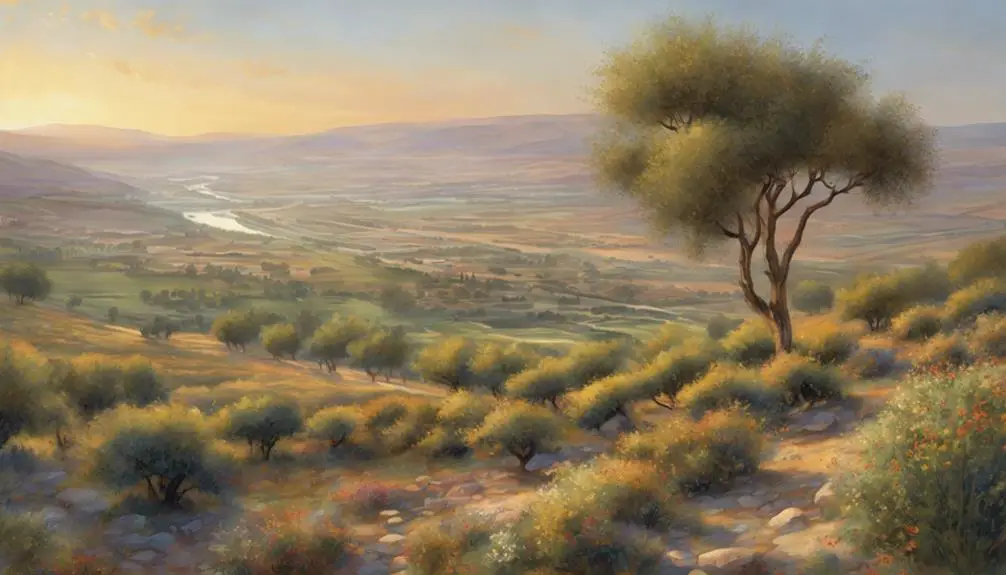
Shifting focus to the Valley of Jezreel, we observe another significant biblical landscape, rich in historical and prophetic implications. This valley, cradling ancient narratives, embodies a crucial crossroad of past civilizations and divine narratives. Jezreel's significance in biblical texts isn't merely geographical; it's a testament to pivotal battles, divine justice, and prophetic revelations that have shaped the faith and understanding of generations.
The agricultural importance of the Valley of Jezreel can't be overstated. It's a fertile expanse, historically serving as the breadbasket for the region. This fertility not only sustained populations but also attracted various empires, making Jezreel a focal point of conflict and conquest. The valley's productivity and strategic location have made it a symbol of God's provision and human struggle throughout biblical history.
Analyzing Jezreel in a scholarly manner reveals layers of meaning beyond its physical attributes. It's a landscape where divine intervention intersects with human history, offering lessons on morality, faith, and the consequences of actions. The valley's role in prophetic visions further underscores its spiritual significance, serving as a stage for events that transcend time.
In essence, the Valley of Jezreel encapsulates a rich tapestry of biblical themes, from God's bounty to the inevitability of divine justice. Its stories are a mosaic of human endeavor, divine will, and the relentless march of history, making it an indispensable study for those seeking to understand the biblical narrative in all its complexity.
Valley of Achor
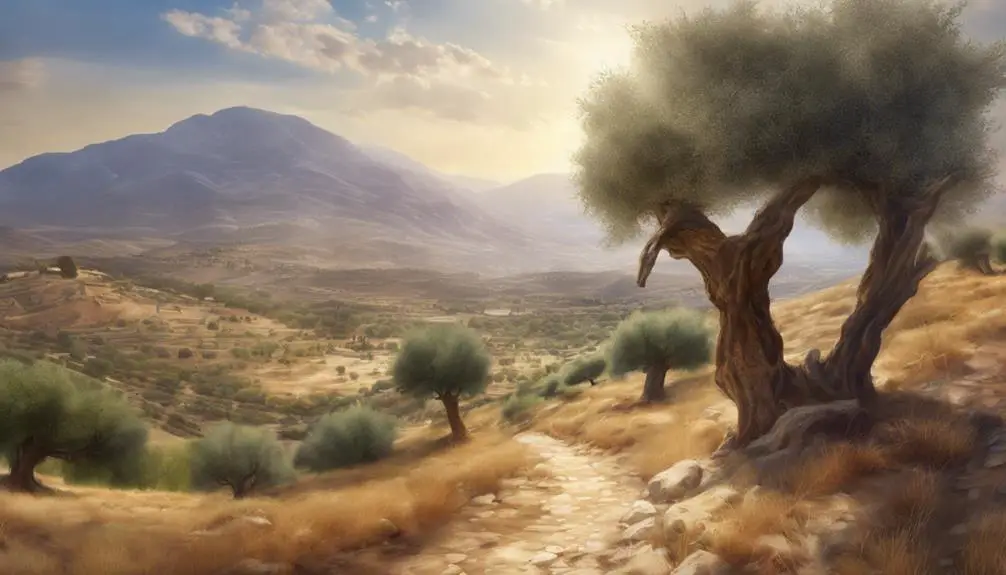
While the Valley of Jezreel serves as a testament to divine providence and historical conflict, the Valley of Achor holds a distinct narrative, deeply entrenched in themes of sin, redemption, and covenant in biblical lore. You'll find Achor's redemption is a pivotal moment in the scriptural narrative, illustrating the transformation from a place of trouble to one of hope.
The historical significance of the Valley of Achor is profound, representing not just a physical location but a metaphorical space where the consequences of sin are met with the opportunity for restoration. This valley, first mentioned in the context of Achan's sin after the battle of Jericho, becomes a site of divine justice and, subsequently, a symbol of hope.
Here's a closer look at the Valley of Achor in biblical context:
Aspect |
Detail |
Significance |
|---|---|---|
Location |
Near Jericho |
Site of Achan's sin |
Event |
Achan's transgression |
Catalyst for divine intervention |
Consequence |
Achan's punishment |
Illustrates the seriousness of disobedience |
Transformation |
From trouble to hope |
Represents God's mercy and redemption |
Symbolism |
Covenant and hope |
A future promise of reconciliation |
In an analytical lens, the Valley of Achor serves as a critical study in contrasts, from its initial association with sin and punishment to its eventual standing as a symbol of redemption and covenantal promise. This duality not only underscores the gravity of disobedience but also the boundless capacity for forgiveness and renewal inherent in the divine narrative.
Valley of Elah
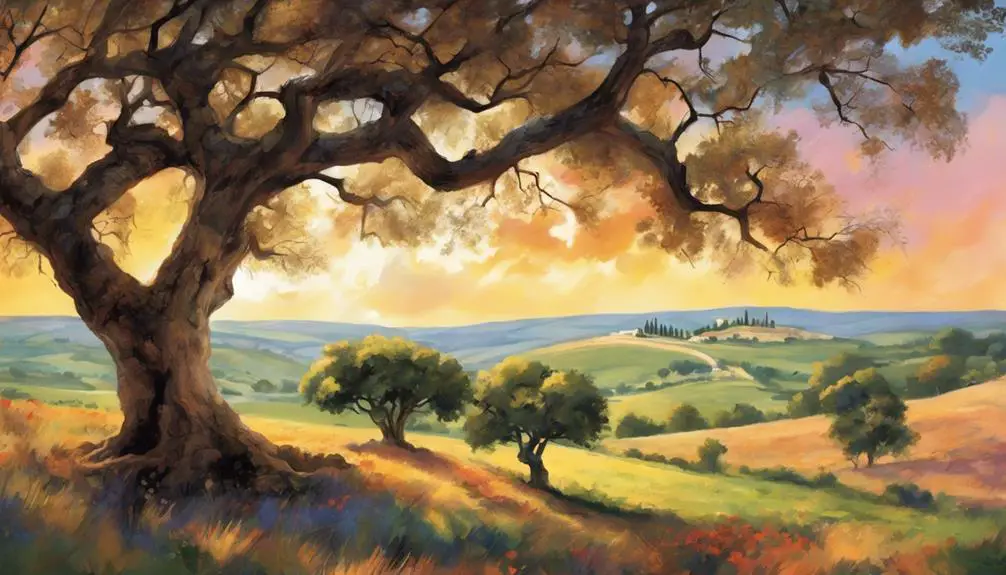
Turning our focus to the Valley of Elah, it's essential to recognize this site as not only a geographical landmark but also a pivotal setting for one of the most renowned biblical narratives—the battle between David and Goliath. This valley, nestled between the cities of Socoh and Azekah, served as the backdrop for the epic showdown that epitomizes the triumph of faith and valor over seemingly insurmountable odds. The giant confrontation that unfolded in this locale is a testament to the power of a shepherd's courage, which, against all expectations, led to a monumental victory that has resonated through ages.
Analyzing the narrative, one can't help but marvel at how the Valley of Elah functions not merely as a physical setting but as a metaphorical crossroads of fear and faith. The Israelites, encamped on one side of the valley, and the Philistines, including the formidable Goliath, on the other, encapsulate the stark contrast between daunting challenges and the potential for divine intervention. The shepherd's courage, embodied by David, emerges not from physical prowess but from an unwavering belief in divine support, highlighting a profound lesson in reliance on faith over might.
In the context of biblical geography, the Valley of Elah's significance extends beyond its role in this singular event. It symbolizes the arena where human limitations are transcended through faith. This narrative invites reflection on the dynamics of fear, faith, and the realization that, often, victory in life's battles hinges not on the size of the adversary but on the depth of one's conviction and courage.
Valley of Siddim
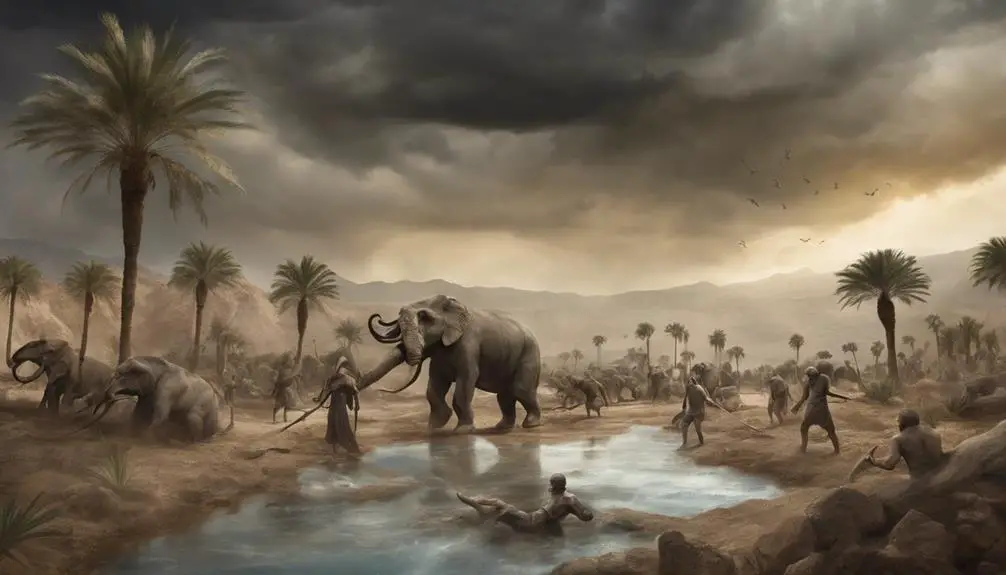
Exploring the Valley of Siddim unveils a complex tapestry of biblical history, where the narrative of warfare and divine judgment intertwines with the fate of ancient cities. This valley, mentioned prominently in the context of ancient battles, serves as a pivotal backdrop for the conflict between the kings of Sodom and Gomorrah and their adversaries. The significance of the Valley of Siddim extends beyond its geographical location, becoming a symbol of divine retribution and moral decay in biblical texts.
The presence of bitumen pits in the Valley of Siddim is a detail of notable interest, highlighting the valley's unique geographical features. These pits not only played a practical role in the ancient economy, due to the valuable resources they provided, but also contributed to the area's strategic importance in ancient battles. The narrative recounts how these pits became traps for the kings' armies, demonstrating the unpredictable nature of warfare and the landscape's influence on historical outcomes.
Scholarly analysis of the Valley of Siddim illuminates the interconnectedness of geography, economy, and divine narrative in the Bible. The valley's mention in the context of warfare underscores the perpetual struggle for power and survival in the ancient Near East. Furthermore, the divine judgment that befalls the cities associated with this valley serves as a cautionary tale, reinforcing moral and ethical lessons within the biblical text.
Valley of Baca

The Valley of Baca, often interpreted as a metaphor for profound hardship or spiritual journey, holds significant symbolic resonance within biblical literature. This valley, mentioned in Psalms, embodies the spiritual significance and pilgrimage symbolism that deeply resonate with believers navigating their own valleys of sorrow or challenge. As you delve into the layers of meaning, you'll discover that the Valley of Baca isn't just a physical location but a transformative spiritual passage.
Aspect |
Symbolism |
|---|---|
Location |
Not a specific place, but a metaphorical valley of hardship |
Spiritual Journey |
Represents a pilgrim's passage through trials towards spiritual enlightenment |
Water |
Symbolizes divine intervention and sustenance in difficult times |
Transformation |
The transformation of hardship into a source of blessing and growth |
In the biblical context, the Valley of Baca is a place where pilgrims shed tears in their journey toward the divine presence, symbolizing the struggles one faces in pursuit of spiritual growth. However, it's also a place of transformation, where the very tears shed become sources of sustenance, as if springs of water emerge in the desert, rejuvenating the weary traveler. This vivid imagery serves not only to illustrate the physical hardships of a pilgrimage but also to underscore the spiritual resilience and growth that come from enduring and overcoming life's challenges.
The spiritual significance and pilgrimage symbolism of the Valley of Baca thus offer profound insights into the human condition, encouraging believers to find strength and sustenance in their faith as they navigate their own valleys of hardship.
Valley of Dry Bones
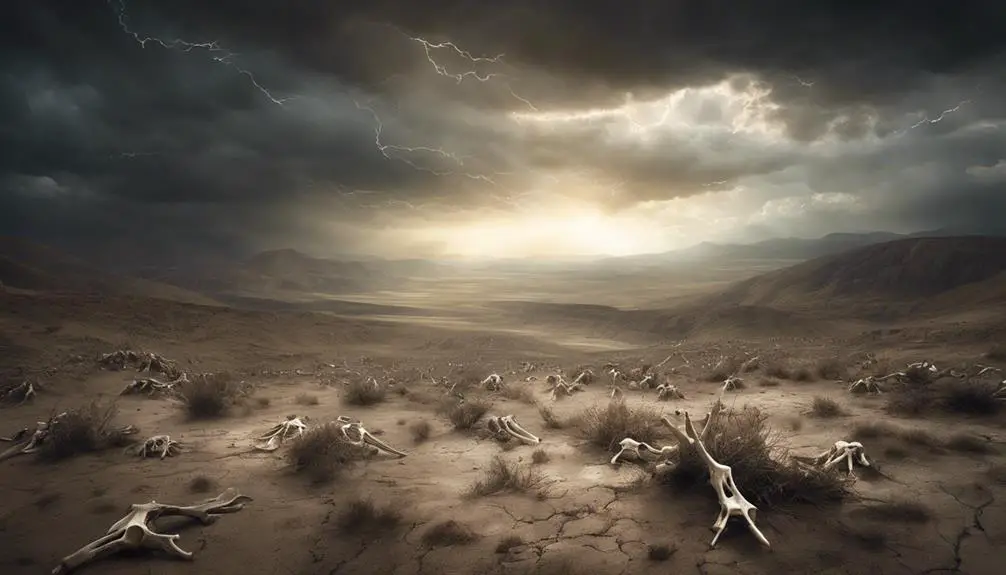
Moving from the metaphorical terrain of the Valley of Baca to another symbolic landscape, we encounter the Valley of Dry Bones, a profound biblical vision that speaks to themes of resurrection and renewal. Found within the book of Ezekiel, this valley serves as a powerful representation of prophetic symbolism and resurrection imagery, offering a vivid depiction of hope and restoration for the people of Israel.
The narrative unfolds as Ezekiel is brought by the Spirit of the Lord into a valley filled with dry bones. This vision symbolizes the desolation and hopelessness of Israel during its exile, yet it also foretells the nation's spiritual revival and physical restoration. Through Ezekiel, God promises to breathe life into these bones, signifying the rejuvenation of Israel.
To paint a picture for the audience, consider these elements:
- *Dry bones scattered across the valley*, representing the lost vitality and despair of the exiled Israelites.
- *The breath of God*, bringing life into the bones, symbolizes divine intervention and the promise of renewal.
- *The rattling sound as bones come together*, illustrating the process of reassembly and the beginnings of restoration.
- *The covering of flesh and skin on the reassembled bones*, depicting the rejuvenation of the nation.
- *The standing of a vast army*, symbolizing the revitalized community of Israel, ready to reclaim its place and identity.
This vision, rich in prophetic symbolism and resurrection imagery, serves not only as a promise to the exiled Israelites but also as a timeless message of hope and renewal for all who encounter desolation.
Frequently Asked Questions
How Have Modern Archaeological Findings Impacted Our Understanding of the Geographic Locations and Historical Contexts of the Valleys Mentioned in the Bible?
Modern archaeological findings, especially valley excavations, have significantly enhanced our understanding of the geographic locations and historical contexts of ancient valleys.
These excavations, coupled with advanced geographic methodologies, allow researchers to more accurately pinpoint where these valleys are located and understand the civilizations that once thrived there.
This analytical approach has provided a more detailed and objective view of the past, shedding new light on historical narratives.
In What Ways Have the Symbolic Meanings of These Valleys Influenced Contemporary Spiritual Practices and Religious Interpretations?
In analyzing the allegorical allure of valleys, you'll discover their deep-seated symbolic significance shapes spiritual practices and religious readings.
Valley pilgrimages and spiritual metaphors derived from these areas foster a profound personal and communal connection to faith. They're not just geographical features but also spiritual signposts, guiding believers through life's lows and highs.
This understanding enriches your spiritual journey, making ancient narratives relevant in modern religious expressions and explorations.
Can You Explain the Significance of Valleys in Biblical Prophecy and Eschatology Beyond the Specific Examples Provided in the Article?
You're diving into how valleys symbolize pivotal moments in prophetic narratives and eschatological visions. These valley battles aren't just historical recounts; they're prophetic metaphors for spiritual warfare, judgment, and redemption.
Analyzing these motifs reveals a rich tapestry of meaning, suggesting that valleys in prophecy serve as arenas where ultimate moral and spiritual battles unfold, shaping the future destiny of humanity in the grand narrative of divine intervention and ultimate victory.
How Do the Narratives Surrounding These Valleys Compare or Contrast With Valley Symbolism Found in Other Ancient Cultures and Religions?
As you dive into ancient narratives, you'll find valley metaphors are a universal language, echoing through time. These metaphors often symbolize life's trials or spiritual journeys, showcasing remarkable cultural parallels.
While exploring various traditions, you'll notice how valleys serve as crossroads of human experience, reflecting both struggle and hope. This analytical journey reveals that, despite diverse backgrounds, humans have consistently found profound meaning in the contours of the earth's landscape.
What Role Do These Valleys Play in the Larger Narrative of the Bible, Considering They Are Not the Primary Focus of the Stories in Which They Appear?
You're exploring how valleys, though not the main focus, enrich narratives by offering deep valley metaphors and geographic significance.
These landscapes serve as more than just backdrops; they embody challenges, transitions, and revelations integral to the overarching themes.
Conclusion
In traversing the valleys of the Bible, you've journeyed through shadows of death, fields of battle, and lands of promise. Each valley, from Jezreel to Dry Bones, serves as a testament to resilience, faith, and transformation.
They symbolize not just geographical locations but spiritual passages. As you reflect on these valleys, consider how they mirror the valleys in your own life, inviting introspection and growth. In understanding their biblical significance, you uncover deeper layers of your spiritual landscape.

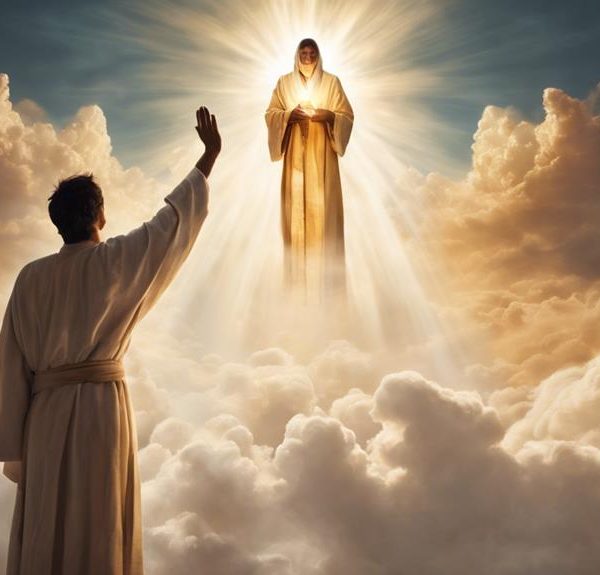
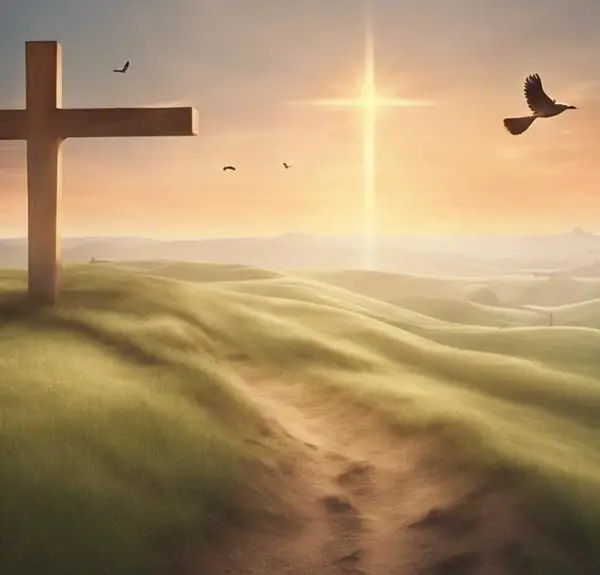
Sign up